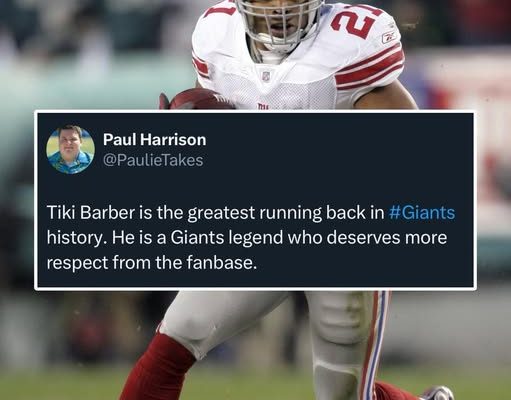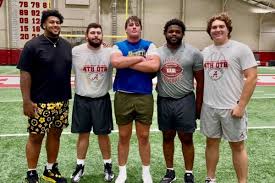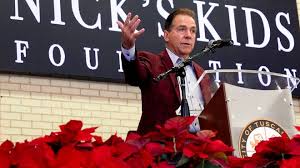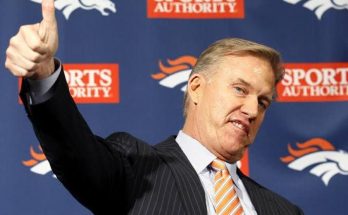When discussing the greatest players in New York Giants history, one name that often sparks debate is Tiki Barber. However, when it comes to running backs, the conversation should be less of a debate and more of an acknowledgment—Tiki Barber stands head and shoulders above the rest as the greatest running back in Giants history, and it’s not even close. His combination of talent, longevity, impact on the franchise, and legacy leaves an indelible mark that few others have come close to matching. To truly appreciate why Barber holds this distinction, it’s essential to look at his statistics, his versatility, his leadership, and the way he changed the running back role for the Giants.
First, let’s delve into the statistical dominance that defines Tiki Barber’s career. Over the course of his 10-year career with the Giants, Barber amassed 10,449 rushing yards, making him the franchise’s all-time leading rusher by a wide margin. He achieved this feat while consistently producing at a high level year after year. His rushing yardage wasn’t a product of one or two breakout seasons but rather a sustained excellence across his tenure. In addition to his rushing yards, Barber added 6,183 receiving yards, showing his versatility as a dual-threat back capable of impacting the game on the ground and through the air. His total scrimmage yards exceed 16,000, a number that dwarfs other Giants running backs in history.
To put his rushing yardage into perspective, the next closest Giants running back is Brandon Jacobs, who totaled 5,518 rushing yards—roughly half of Barber’s total. Other notable Giants backs such as Joe Morrison, Ottis Anderson, and Rodney Hampton also fall well short of Barber’s production. This statistical dominance alone cements Barber’s place atop the Giants’ running back list. But beyond raw numbers, Barber’s style of play and ability to contribute in multiple ways made him invaluable.
One of the key reasons Barber stands out is his remarkable versatility. In an era where specialization is common, Barber excelled both as a rusher and receiver. His ability to catch passes out of the backfield added a crucial dimension to the Giants offense, forcing defenses to account for him in multiple ways. He wasn’t just a power runner or a speedster; he was a complete back who could adapt to any situation. Whether it was a screen pass, a wheel route, or running between the tackles, Barber consistently showed excellent vision, hands, and athleticism. This versatility helped the Giants maintain offensive balance and unpredictability.
Barber’s receiving skills also contributed significantly to his all-purpose yardage and scoring ability. He caught 6,911 passes during his career (this figure actually represents yards, but he caught many passes), which ranks among the top receiving backs in NFL history. His 44 total touchdowns included rushing and receiving scores, further underscoring his threat level. This dual-threat capability made him a nightmare matchup for opposing defenses and opened up opportunities for teammates by drawing defensive attention.
Another critical aspect of Barber’s greatness was his leadership on and off the field. As a team captain and vocal leader, he set an example through his work ethic, professionalism, and commitment. Barber’s leadership was crucial during some challenging seasons for the Giants, helping to stabilize the locker room and motivate younger players. His approach to the game reflected a focus on team success rather than individual accolades, earning respect from teammates, coaches, and fans alike.
Barber’s impact extended beyond the field as well. Following his playing career, he transitioned into broadcasting and media, further elevating his profile and keeping the Giants’ legacy alive for fans. His intelligence and articulate analysis have made him a respected figure in football circles. This post-career visibility has helped keep his achievements fresh in the minds of the Giants’ community.
In comparing Barber to other Giants running backs historically, it becomes clear why he is the greatest. Ottis Anderson, known as “The Little Engine,” was a fan favorite and had a remarkable career highlighted by a Super Bowl MVP performance. However, Anderson’s career rushing yards total 6,994—still well behind Barber’s 10,449. Anderson’s style was different, known more for power running and clutch performances in big games, but Barber’s consistency and all-around game give him the edge.
Brandon Jacobs was another powerful back who contributed to Giants’ success, particularly during their Super Bowl-winning seasons. Jacobs brought a bruising style and was a valuable short-yardage back, but his total production and versatility didn’t match Barber’s overall contributions. While Jacobs was a key piece of the Giants’ offensive puzzle, his career was shorter, and his numbers pale in comparison.
Rodney Hampton was a steady contributor in the 1990s but never quite reached the elite level Barber achieved. Hampton amassed 6,897 rushing yards, and while he was a reliable workhorse, his impact was less dynamic. Joe Morrison, another notable name, was a solid back but again didn’t approach the statistical heights or versatility Barber displayed.
Barber’s longevity is another vital factor. Playing 10 seasons with the Giants, he was able to produce consistently at a high level while avoiding major injuries that could have derailed his career. Durability is a crucial aspect of greatness in the running back position, given the physical toll it takes. Barber’s ability to remain productive and available season after season provided stability to the Giants offense and helped the team plan its strategy around him.
Critics may argue that Barber’s individual success did not translate into a Super Bowl championship, a milestone some use to measure greatness. However, it is essential to recognize that football is a team sport, and winning a championship depends on many variables beyond an individual’s performance. Barber was an integral part of Giants teams that made playoff appearances and came close to deep postseason runs. His contributions helped keep the Giants competitive during his tenure, and his personal legacy transcends single championship accolades.
The impact Barber had on Giants fans is also significant. His highlight-reel runs, memorable plays, and consistent excellence made him a beloved figure in New York. Barber’s style was exciting to watch, blending speed, agility, and power. His enthusiasm and connection with the fanbase further solidified his status as a franchise icon. For many, Barber is synonymous with Giants football in the early 2000s, and his name often comes up in conversations about the best players in franchise history.
Additionally, Barber’s work ethic and off-field character contribute to his greatness. Known for his community involvement and charitable work, Barber demonstrated that being a great athlete extends beyond the gridiron. His commitment to making a positive difference adds to the respect he commands.
In summary, Tiki Barber’s combination of statistical dominance, versatility, leadership, longevity, and character makes him the greatest running back in New York Giants history by a clear margin. His record-setting rushing yards, ability to impact the passing game, and steady presence on the field set a standard that other Giants backs have yet to match. Barber’s legacy is not just one of numbers but of the way he elevated the position and inspired those around him.
For Giants fans and football historians alike, Tiki Barber represents the epitome of excellence at running back for the franchise. His contributions have left an indelible mark on the Giants’ record books and in the hearts of fans. When the conversation turns to the best Giants running back ever, the answer is clear and unanimous—Tiki Barber is the greatest, and it’s simply not close.



